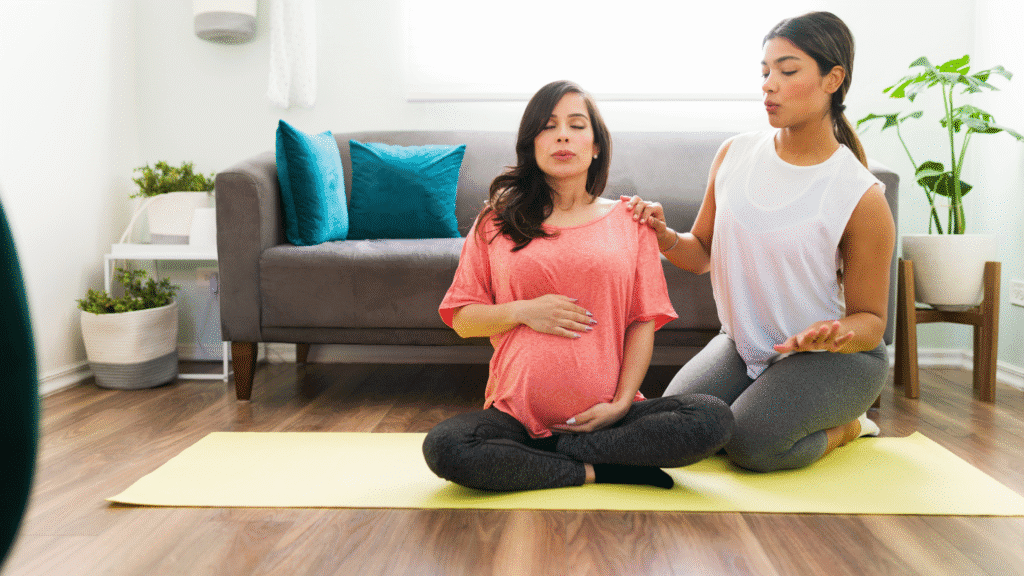As your due date approaches, it’s completely natural for your thoughts to turn towards labour and delivery. A common question I hear from the expectant mothers I care for is, “How will I manage the pain and intensity of labour?” While modern medicine offers excellent options for pain relief, it’s incredibly empowering to know that you possess powerful tools within your own body to cope effectively: your breath and your ability to move.
My name is Dr. Vrushali Pillai, and as a Senior Consultant Obstetrician & Gynaecologist at Borneo Hospital, Thane – part of the Borneo Hospitals group with branches in Nashik, Chhatrapati Sambhaji Nagar, and Raipur City – my passion is to support women in having a safe and positive birth experience. Learning and practising effective Breathing Techniques and active labour positions can transform your experience, helping you feel more in control, calm, and able to work with your body.
This article will serve as your practical guide to these invaluable skills. We’ll explore specific Breathing Techniques for each stage of labour and positions that can ease discomfort and facilitate progress. These techniques are beneficial for all labouring women, whether you are aiming for a natural, low-intervention birth or planning to use medical pain relief options.
The Power of the Breath: Why Do Breathing Techniques Work?
Controlled breathing during labour is much more than just a distraction; it has profound physiological and psychological benefits.
1. The Physiological Benefits (The Science of Calm):
- Oxygenation: Slow, rhythmic breathing ensures a steady supply of oxygen flows to your hard-working uterine muscle and, most importantly, to your baby. A well-oxygenated uterus can function more efficiently.
- Reduces Muscle Tension: When we feel pain or fear, our instinctive reaction is to tense up, hold our breath, and clench our muscles. This tension can create resistance against your contracting uterus, which can actually increase pain. Conscious, slow exhalations help release this tension, allowing your body to open more easily.
- Calms the Nervous System: Deliberate, focused breathing activates your parasympathetic nervous system – the body’s ‘rest and digest’ system. This counteracts the ‘fight or flight’ stress response (which is driven by adrenaline and can sometimes slow labour down), helping you stay calmer and more relaxed.
2. The Psychological Benefits (Focus and Control):
- Provides a Rhythmic Focus Point: During an intense contraction, it can be hard to think. Focusing on a specific breathing pattern gives your mind a concrete task and a rhythm to hold onto, which can make the sensation feel more manageable.
- Creates a Sense of Participation: Actively using your breath helps you feel that you are participating in and managing your labour, working with each contraction, rather than feeling like labour is something that is just happening to you.
- The Grounding Power of Ritual: The predictability of breathing in and out in a set pattern can be very grounding and reassuring during the unpredictable journey of labour, giving you an anchor in the storm.

Breathing Techniques for the Different Stages of Labour
Here are some specific Breathing Techniques you can practice and use during labour.
1. For Early Labour (The Latent Phase):
- Your Goal: To conserve energy, stay calm, and relax through milder, more spaced-out contractions.
- The Technique: Slow, Deep Breathing (Abdominal Breathing):
- As you feel a contraction begin, take a slow, deep “organising” breath in through your nose and let it all out with a gentle sigh.
- Throughout the contraction, breathe in slowly through your nose, imagining you are filling a balloon deep in your belly. Let your abdomen expand. Count to 4 or 5 as you inhale.
- Then, exhale slowly and completely through your mouth or nose for a slightly longer count, perhaps to 6 or 8. As you exhale, consciously release any tension from your jaw, shoulders, and hands.
- Continue this deep, slow rhythm until the contraction fades, then take another relaxing breath. Use this technique between contractions as well to stay relaxed.
2. For Active Labour:
- Your Goal: To manage stronger, more intense, and closer contractions when slow breathing is no longer enough to keep you focused.
- Technique 1: Light, Paced Breathing:
- Start with your cleansing breath as the contraction begins.
- As the intensity builds, switch to lighter, shallower breaths in and out through your mouth at a comfortable, accelerated pace – about one breath per second. Keep it light and quiet. Think “hee-hee-hee-hee”. Keep your jaw and shoulders as soft and relaxed as possible.
- As the contraction subsides, finish with another long, deep, cleansing exhale.
- Technique 2: Patterned Breathing (e.g., 3:1 Breathing):
- This technique is useful for very intense contractions when you need an even stronger point of focus.
- After your initial cleansing breath, the pattern is: three quick, light “hee” breaths (in and out), followed by a longer, more audible “hooooo” or “puuuuff” breath out.
- The rhythm could sound like “hee-hee-hee-hoooo… hee-hee-hee-hoooo…” Focusing on this pattern can be a powerful distraction and helps prevent you from holding your breath.
3. For the Transition Phase (The Most Intense Stage):
- Your Goal: To cope with very powerful contractions, often when you feel a premature urge to push but your cervix isn’t quite fully dilated yet.
- The Technique: Panting or “Candle-Blowing” Breaths: If you feel an overwhelming urge to bear down but have been advised by your doctor or midwife at Borneo Hospital to wait, this technique can help. Take short, shallow “pant-pant-blow” or “puff-puff-blow” breaths, like you are blowing out candles. This helps prevent you from holding your breath and engaging in a full push.
4. For the Pushing Stage (Second Stage):
- Your Goal: To work effectively with your body’s natural expulsive contractions to birth your baby.
- The Technique: Spontaneous or “Exhale” Pushing (J-Breathing): Instead of the traditional long breath-holding and purple-faced pushing, modern advice often favours following your body’s lead.
- As you feel the natural, involuntary urge to push with a contraction, take a deep breath in.
- Then, as you bear down, release the air slowly and controllably, often with a deep grunting or groaning sound, for about 5-7 seconds. This works with your body’s effort.
- Quickly take another breath and repeat this as needed throughout the contraction. Your obstetrician or midwife will provide guidance on the best way to push for you.
The Power of Movement: Active Positions for Labour
Staying mobile and changing positions frequently can significantly improve comfort and progress in labour. Lying flat on your back is often the least effective position.
- Why Movement Helps: Being upright uses gravity to help your baby descend. Movement can help your baby rotate into an optimal position for birth. Certain positions can relieve pressure on your back and open up your pelvis, giving your baby more room. It also gives you a sense of control.
- Positions for Early Labour: Walking around, gently swaying your hips, rocking back and forth, or sitting on a birthing ball can all be very helpful.
- Positions for Active Labour:
- Upright & Forward-Leaning: This is a fantastic category of positions. Lean forward against your partner, a wall, or the raised head of the hospital bed during contractions. Leaning over a birthing ball is also excellent. This takes pressure off your lower back.
- Kneeling or Hands-and-Knees: This position is a great option for relieving intense back labour pain. It allows your belly to hang forward and can help the baby rotate. You can use pillows or the bed at Borneo Hospital to support your knees and hands.
- Sitting: Sitting upright on a chair (you can even sit facing the back of the chair and lean forward), on the toilet (this helps relax perineal muscles), or on a birthing ball helps to open the pelvis using gravity.
- Side-Lying: This is a good resting position, especially if you need a break or have had an epidural and your mobility is limited. Place pillows between your knees and under your bump for comfort and support.
- Squatting (with support): Squatting opens the pelvic outlet to its widest, but it can be very tiring. It’s often effective during the pushing stage for short periods, with strong support from your partner, a doula, or a squatting bar if available.
- Our Supportive Environment: At Borneo Hospital, we encourage labouring women to be mobile and find positions that feel most comfortable, as long as it is medically safe for you and your baby. Our labour rooms provide space for movement, and we can offer aids like birthing balls where feasible.

Putting It All Together: The Synergy of Breath and Movement
The real magic happens when you combine these techniques. For example:
- Gently swaying your hips while practicing slow, deep breathing during an early labour contraction.
- Getting onto your hands and knees during an intense back labour contraction while using patterned breathing to cope.
- Leaning over a birthing ball and having your partner apply firm counter-pressure to your lower back. Your birth partner can be invaluable here, suggesting a new position if you seem uncomfortable or reminding you of your breathing pattern if you lose focus.
Practice is Key! Preparing During Pregnancy
These Breathing Techniques are skills, and they are most effective when they feel instinctive. You wouldn’t run a marathon without training, and preparing for labour is similar.
- Attend Antenatal Classes: Childbirth education classes are the best place to learn and practice these techniques under expert guidance. Borneo Hospital can recommend good quality local classes that focus on labour preparation.
- Practice Daily: Incorporate deep breathing into your daily routine during pregnancy for just 5-10 minutes. It’s a wonderful tool for relaxation even before labour begins.
- Involve Your Partner: Practice together! This helps your partner learn the techniques so they can be a confident and effective coach for you on the day. They can remind you of your rhythm and provide physical support for different positions.
A Note on Medical Pain Relief
These techniques are incredibly powerful tools for coping with labour. However, it’s also important to be realistic. Labour can be long and intense, and every woman’s experience is different. Choosing to use medical pain relief options, such as an epidural, which are readily available at Borneo Hospital, is a valid personal choice and is absolutely not a ‘failure’ of natural coping. In fact, these Breathing Techniques are still extremely useful for staying calm and focused before medical pain relief is administered or takes full effect.
Mastering a few simple Breathing Techniques and feeling confident to move your body into active, upright positions are empowering and effective ways to manage the intensity of labour. They allow you to participate fully in your birth experience, working with your body to bring your baby into the world. The benefits are significant – increased comfort, better coping with pain, a greater sense of control, and potentially a smoother labour progression.
Preparation and practice are what build confidence. I encourage all expectant mothers to learn these skills. The dedicated and experienced team at Borneo Hospital is here to support you with expert medical care and guidance as you approach this incredible, life-changing day. We look forward to helping you welcome your baby.



